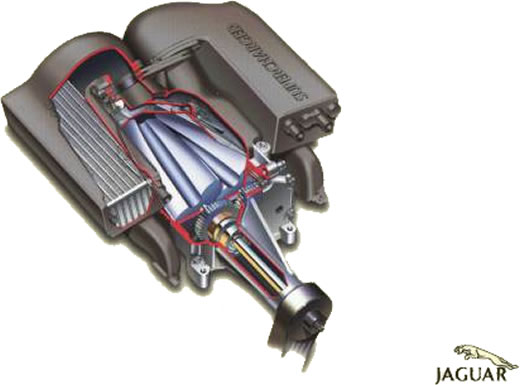- Login or Register
No account yet? Sign up
I believe that heat loss component depends on what their going to do with the exhuast manifolds. In terms of materials. Also since the exhuast speed is so high, there may be a very minute difference with the pipe lengths on this design versus a midbank design.autogyro wrote:Looks like a torturous route for the exhaust manifold to join the turbine housing.
If it is like that in the car, it will be a devils own job to prevent heat loss from the manifolds.
It looks like it has split chambers? Air filter in the middle, and air intake tracts from the intercooler on either side?Whats the big box on the top, heat exchanger for charge cooling?
Well i doubt we are being shown charge coolers here.I would have expected the charge cooler to be in the side pods and to be much bigger.
Yes, could be water jacketed. With cooling to a heat exchanger to plumbed back to the engine's cooling system.If the unit between the compressor and turbine is the MG, that might have a cooling issue as well.
That´s what the Renault configuration was about, with two vice-versa separate entries for a 3 in 1 exhaust manifold each, notably missing here, although it should provide a far better solution regarding admission and responding behaviour, which should benefit the intended 125.000 revs of the charger, doesn´t it?You may have two entries to the turbine but you may have only one turbine and one turbine stage.

It is almost to scaleautogyro wrote: Clever drawing.
When are you going to show us the real one?
I dont think the 10 inch rear wheels will work very well.
I suppose that is because of the crank height difference to the reference plane v8 to v6.
If the 2014 Williams is like that, you have got an awful lot to cram in the side pods.
Love the stove pipe at the back though.
Sorry I forgot that.It is almost to scale
Williams drive shaft is steeply inclined.
If we take homologating literally, it means development of the engine is allowed inbetween seasons. However, do note engines have to last twice as long and I expect the amount of engines allowed for 1 season, reduced to 4. Meaning even if you were allowed to upgrade, you were stuck with the none-upgraded engine for 5 races of the 20.agip wrote:[...]the manufactures have agreed to homologate the engines on March 1st 2014, so they have until then to develop them. If one manufacturer has a clear advantage over others, they will be able to enjoy that for a while but discussions will inevitably ensue to allow some retuning, as happened when F1 switched to V8s after 2006.
So we'll have frozen engines again?

Homologation means indeed that there will be no development - except for failures - to the five engines that will be legal in 2013 or the additional engines a team might be using with penalties.turbof1 wrote:If we take homologating literally, it means development of the engine is allowed inbetween seasons. However, do note engines have to last twice as long and I expect the amount of engines allowed for 1 season, reduced to 4. Meaning even if you were allowed to upgrade, you were stuck with the none-upgraded engine for 5 races of the 20.agip wrote:[...]the manufactures have agreed to homologate the engines on March 1st 2014, so they have until then to develop them. If one manufacturer has a clear advantage over others, they will be able to enjoy that for a while but discussions will inevitably ensue to allow some retuning, as happened when F1 switched to V8s after 2006.
So we'll have frozen engines again?
Renault engine here: (racecar-engineering) http://www.racecar-engineering.com/news ... f1-engine/ringo wrote:... Does anyone have an image of the Renault concept hanging around...

So anyone got a clue??Holm86 wrote:But why do Mercedes reveal pictures of a complete engine this soon?? To put pressure on FIA to keep the engine regulations for 2014??

The rules mandate a maximum of two air intakes located between the front of the cockpit and 500mm before the rear axle and more than 200mm above the reference plane.markc wrote:Renault engine here: (racecar-engineering) http://www.racecar-engineering.com/news ... f1-engine/ringo wrote:... Does anyone have an image of the Renault concept hanging around...
Very interesting! I had previously assumed the airbox redundant thanks to the turbo (...and being too lazy to check rules), but looking at Merc, Renault and PURE (defunct but still interesting) designs I see it's footprint engine side still there...? Digging further I can see the rules mandate the airbox inlet still above the drivers head... I consider myself schooled in the matter!
Renault have shown more ancillaries attached - airbox direct to turbo, and a box where the airbox would have terminated in the NA engines of old. Merc has the airbox terminating in the NA fashion but feeding the turbo air, with the same structure also handing the pressured air inlet to engine (chambered one assumes). Intercooler in the box? or is that's position mandated ala turbo?

Of course not, Renault and Mercedes have invested a lot of money in it, FIA can't stop it anymore.Holm86 wrote:So anyone got a clue??Holm86 wrote:But why do Mercedes reveal pictures of a complete engine this soon?? To put pressure on FIA to keep the engine regulations for 2014??
